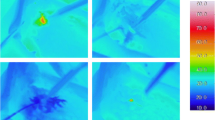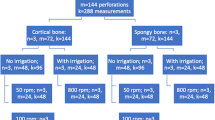Abstract
Background
Drill-induced heat has been suspected as a cause of tissue injury, and there are ample experimental data to substantiate the implication. However, no clinical results have been presented with measurement of temperature in the vicinity of neural structures during the actual spinal procedures.
Methods
Using a thermocouple, temperature in the gutters drilled in the midline and the lateral margins of the lamina was monitored closely in 61 patients, who underwent the French-door style of cervical spino-laminoplasty. The drilling was performed intermittently for a duration of 5 or 10 seconds, using 3- or 5-mm diamond burrs with sufficient continuous cooling irrigation. The correlations between bone temperature elevation and postoperative sensorimotor symptoms were then analyzed.
Results
In the lateral gutters at the most cephalad level (typically C3), where the drilling was performed underneath an overlying bundle of muscle attached to C2's spinous process, the temperature rose significantly. This occurred even with 5-second drilling sessions. The average peak temperature was 44 °C at this level. At all other sites, the temperature was maintained below 40 °C. In three patients, transient neurological deficit developed postoperatively, which did not correlate with the incidence of bone temperature elevation.
Conclusions
Intermittent drilling with sufficient irrigation can prevent thermal neuronal damage generated by high-speed drills. Drilling with small diamond burrs in deep and narrow spaces covered by overlying muscles predisposes to inadequate irrigation and thermal elevation. Continuous, protracted drilling without frequent irrigation may result in excessive heat generation and nerve injury.



Similar content being viewed by others
References
Abbas GM, Jones RO (2001) Measurements of drill-induced temperature change in the facial nerve during mastoid surgery: a cadaveric model using diamond burs. Ann Otol Rhinol Laryngol 110:867–870
Abouzgia MB, James DF (1997) Temperature rise during drilling through bone. Int J Oral Maxillofac Implants 12:342–353
Aslan A, Vatansever HS, Aslan GG, Eskiizmir G, Giray G (2005) Effect of thermal energy produced by drilling on the facial nerve: histopathologic evaluation in guinea pigs. J Laryngol Otol 119:600–605
Augustin G, Davila S, Mihoci K, Udiljak T, Vedrina DS, Antabak A (2008) Thermal osteonecrosis and bone drilling parameters revisited. Arch Orthop Trauma Surg 128:71–77
Augustin G, Davila S, Udiljak T, Vedrina DS, Bagatin D (2009) Determination of spatial distribution of increase in bone temperature during drilling by infrared thermography: preliminary report. Arch Orthop Trauma Surg 129:703–709
Brodkey JS, Miyazaki Y, Ervin FR, Mark VH (1964) Reversible heat lesions with radiofrequency current: a method of stereotactic localization. J Neurosurg 21:49–53
Call WH (1978) Thermal injury from mastoid bone burrs. Ann Otol Rhinol Laryngol 87:43–49
De Vrind HH, Wondergem J, Haveman J (1992) Hyperthermia-induced damage to rat sciatic nerve assessed in vivo with functional methods and with electrophysiology. J Neurosci Methods 45:165–174
Eliasson SG, Monafo WW, Nussbaum G, Olsen L (1986) Differential effects of in vitro heating on rat sciatic nerve branches and spinal nerve roots. Exp Neurol 93:57–66
Hosono N, Miwa T, Mukai Y, Takenaka S, Makino T, Fuji T (2009) Potential risk of thermal damage to cervical nerve roots by a high-speed drill. J Bone Joint Surg Br 91:1541–1544
Kim P, Murata H, Kurokawa R, Takaishi Y, Asakuno K, Kawamoto T (2007) Myoarchitectonic spinolaminoplasty: efficacy in reconstituting the cervical musculature and preserving biomechanical function. J Neurosurg Spine 7:293–304
Kondo S, Okada Y, Iseki H, Hori T, Takakura K, Kobayashi A, Nagata H (2000) Thermological study of drilling bone tissue with a high-speed drill. Neurosurgery 46:1162–1168
Uchiyama S, Yashiro K, Takahashi H, Homma T (1989) An experimental study of spinal cord evoked potentials and histologic changes following spinal cord heating. Spine 14:1215–1219 (Phila Pa 1976)
Conflicts of interest
None.
Author information
Authors and Affiliations
Corresponding author
Additional information
Comment
The authors have performed a nice study to investigate a common teaching regarding heat injury to nerves associated with drilling. They have shown that the use of a diamond bit, particularly in relatively closed spaces, can result in significant temperature changes and that these changes have the potential to cause nerve damage.
Daniel Resnick
Wisconsin, USA
Rights and permissions
About this article
Cite this article
Yamamoto, S., Kim, P., Abe, Y. et al. Bone temperature elevation by drilling friction and neurological outcome in the cervical spino-laminoplasty. Acta Neurochir 155, 2321–2325 (2013). https://doi.org/10.1007/s00701-013-1867-x
Received:
Accepted:
Published:
Issue Date:
DOI: https://doi.org/10.1007/s00701-013-1867-x




